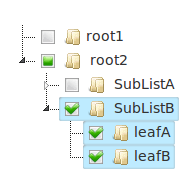The hardware and bandwidth for this mirror is donated by METANET, the Webhosting and Full Service-Cloud Provider.
If you wish to report a bug, or if you are interested in having us mirror your free-software or open-source project, please feel free to contact us at mirror[@]metanet.ch.
The shinyTree package enables Shiny application
developers to use the jsTree library in
their applications.

You can install the latest development version of the code using the devtools R package.
# Install devtools, if you haven't already.
install.packages("devtools")
library(devtools)
install_github("shinyTree/shinyTree")library(shiny)
runApp(system.file("examples/01-simple", package = "shinyTree"))A simple example to demonstrate the usage of the shinyTree package.
library(shiny)
runApp(system.file("examples/02-attributes", package = "shinyTree"))Manage properties of your tree by adding attributes to your list when rendering.
library(shiny)
runApp(system.file("examples/03-checkbox", package = "shinyTree"))Use checkboxes to allow users to more easily manage which nodes are selected.
library(shiny)
runApp(system.file("examples/04-selected", package = "shinyTree"))An example demonstrating how to set an input to the
value of the currently selected node in the tree.
library(shiny)
runApp(system.file("examples/05-structure", package = "shinyTree"))Demonstrates the low-level usage of a shinyTree as an input in which all attributes describing the state of the tree can be read.
library(shiny)
runApp(system.file("examples/06-search", package = "shinyTree"))An example showing the use of the search plugin to allow users to more easily navigate the nodes in your tree.
library(shiny)
runApp(system.file("examples/07-drag-and-drop", package = "shinyTree"))An example demonstrating the use of the drag-and-drop feature which allows the user to reorder the nodes in the tree.
library(shiny)
runApp(system.file("examples/08-class", package = "shinyTree"))An example demonstrating the use of the ability to style nodes using custom classes.
library(shiny)
runApp(system.file("examples/09-themes", package = "shinyTree"))An example demonstrating the use of built-in tree themes.
library(shiny)
runApp(system.file("examples/10-node-ids", package = "shinyTree"))An example demonstrating the ability to label and return node identifiers and classes.
library(shiny)
runApp(system.file("examples/11-tree-update", package = "shinyTree"))An example demonstrating the ability to update a tree with a new tree model. This was broken in the original version as the tree was destroyed upon initialization.
library(shiny)
runApp(system.file("examples/12-types", package = "shinyTree"))An example demonstrating node types with custom icons.
library(shiny)
runApp(system.file("examples/13-icons", package = "shinyTree"))An example demonstrating various ways to use icons on nodes.
library(shiny)
runApp(system.file("examples/14-files", package = "shinyTree"))Demonstrates how to create a file browser tree.
library(shiny)
runApp(system.file("examples/15-data", package = "shinyTree"))Demonstrates how to attach and retreive metadata from a node.
library(shiny)
runApp(system.file("examples/16-async", package = "shinyTree"))Demonstrates how to render a tree asynchronously.
library(shiny)
runApp(system.file("examples/17-contextmenu", package = "shinyTree"))Demonstrates how to enable the contextmenu.
library(shiny)
runApp(system.file("examples/18-modules/app.R", package="shinyTree"))
runApp(system.file("examples/18-modules/app_types.R", package="shinyTree"))Demonstrates how to use shinyTree with shiny modules.
library(shiny)
runApp(system.file("examples/19-data.tree", package = "shinyTree"))Demonstrates how to pass a data.tree to shinyTree.
library(shiny)
runApp(system.file("examples/20-api", package = "shinyTree"))An example demonstrating how to extend the operations on the tree to the rest of the jsTree’s core functionality.
library(shiny)
runApp(system.file("examples/21-options/app_setState_refresh.R", package="shinyTree"))Demonstrates how to fine-tune shinyTree’s behaviour with options.
Specifically: When internal jstree code calls
set_state or refresh, a callback is made so
that the shiny server is notified and observe and
observeEvents for the tree are fired. This can be useful if
the developer would like observe and
observeEvents to run after using updateTree.
(By default, updateTree does not run observe
or observeEvent because it is assumed that the shiny
application knows that the tree is being changed already.)
library(shiny)
library(shinyTree)
runApp(system.file("examples/23-file-icons", package = "shinyTree"))An example demonstrating how to create a file tree with individual icons.
See the Issues page for information on outstanding issues.
The development of this project was generously sponsored by the [Institut de and performed by Jeff Allen. The code is licensed under The MIT License (MIT).
Copyright (c) 2014 Institut de Radioprotection et de Sûreté Nucléaire
Permission is hereby granted, free of charge, to any person obtaining a copy of this software and associated documentation files (the “Software”), to deal in the Software without restriction, including without limitation the rights to use, copy, modify, merge, publish, distribute, sublicense, and/or sell copies of the Software, and to permit persons to whom the Software is furnished to do so, subject to the following conditions:
The above copyright notice and this permission notice shall be included in all copies or substantial portions of the Software.
THE SOFTWARE IS PROVIDED “AS IS”, WITHOUT WARRANTY OF ANY KIND, EXPRESS OR IMPLIED, INCLUDING BUT NOT LIMITED TO THE WARRANTIES OF MERCHANTABILITY, FITNESS FOR A PARTICULAR PURPOSE AND NONINFRINGEMENT. IN NO EVENT SHALL THE AUTHORS OR COPYRIGHT HOLDERS BE LIABLE FOR ANY CLAIM, DAMAGES OR OTHER LIABILITY, WHETHER IN AN ACTION OF CONTRACT, TORT OR OTHERWISE, ARISING FROM, OUT OF OR IN CONNECTION WITH THE SOFTWARE OR THE USE OR OTHER DEALINGS IN THE SOFTWARE.
These binaries (installable software) and packages are in development.
They may not be fully stable and should be used with caution. We make no claims about them.